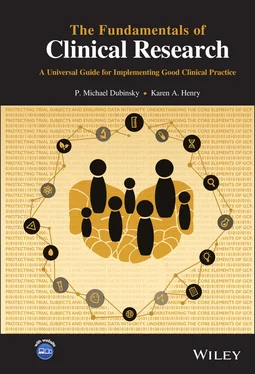6 2.6 A trial should be conducted in compliance with the protocol that has received prior institutional review board (IRB)/independent ethics committee (IEC) approval/favorable opinion.A clinical trial protocol may be implemented only if it has the prior review and approval/favorable opinion of an IRB/IEC. If the protocol is amended, the procedures as described in the amendment may only be implemented if it has the prior review and approval/favorable opinion of an IRB/IEC. The conduct of the trial must comply with the approved protocol.In the real world, it is prudent for those involved in trial conduct to be attentive to approved versions of the protocol and to approved procedures before implementing those procedures. For example, a trial site may receive verbal notification from the IRB/IEC that a protocol/amendment has been approved, and with eagerness to enroll, may consent or administer a new procedure to a subject before receiving documentation of the approval. Upon receipt of the documentation of the IRB/IEC's approval, the date of approval was after the verbal notification and therefore the date of consent and new protocol procedure predated the approved protocol. The implementation of the protocol was therefore a violation of this principle and a violation of the effective protocol, if the scenario pertained to a protocol amendment.Another example where keen attention is needed to prevent noncompliance is that protocol compliance means EXACT compliance with the protocol procedures as described. For example, if vital signs in the schedule of assessments are at 08:00 with a grace period (“window”) of ±5 minutes, and the vital signs were documented as obtained at 08:07, then this is a deviation from the protocol. For an auditor or inspector, rare instances of these deviations may be “acceptable”; however, multiple instances may be classified as chronic noncompliance and warrant a significant audit finding. The sponsor should monitor and note all deviations from the protocol, evaluate the root cause, implement corrective action, and/or amend the protocol as needed to ensure compliance. ( Chapter 21Safety Monitoring and Reporting; Chapter 22Monitoring Overview)
7 2.7 The medical care given to, and medical decisions made on behalf of, subjects should always be the responsibility of a qualified physician or, when appropriate, of a qualified dentist.Only physicians who are qualified by education, training, and experience may provide medical care or make medical decisions on behalf of subjects. These physicians will be qualified not only by general training, but by specialty training if applicable. The local regulations will also determine what qualifications a physician may have to perform certain types of procedures. For example, consideration should be given to the qualifications of the investigator for a trial that evaluates a contrast agent that is administered via infusion for radiographical imaging of liver lesions; i.e., whether the investigator needs to be a radiologist or a hepatologist. Additionally, a busy clinical site should ensure that an individual who is recording adverse effects as reported by a study subject is not inadvertently diagnosing or making decisions about the clinical severity and treatment of the adverse effects. ( Chapter 21Safety Monitoring and Reporting; Chapter 22Monitoring Overview; Chapter 9Investigator and Sponsor Roles and Responsibilities)
8 2.8 Each individual involved in conducting a trial should be qualified by education, training, and experience to perform his or her respective task(s).Each individual, whether they are a sponsor, investigator, or IRB/IEC representative (employee or contractor) should have appropriate qualifications to perform their assigned tasks. The assignment of the tasks and the qualifications of each individual should be documented. There should also be documentation that the individual has been trained on the protocol‐specific procedure or function. Documentation may be in the form of charts of the organizational structure for a team, lists of assigned tasks, current curriculum vitae with copies of certifications as required, and general and protocol‐specific training records. If an individual changes roles during a trial or discontinues performing the trial task or function, the transfer and transition process of the responsibilities should also be documented. Consideration should also be given to conflicts of interest; e.g., someone with significant financial interest in the product or the trial site should not contribute to trial data. ( Chapter 14Trial Management; Start‐up, On‐Study, and Close‐Out; Chapter 15Trial Resourcing and Outsourcing; Chapter 21Safety Monitoring and Reporting; Chapter 22Monitoring Overview)
9 2.9 Freely given informed consent should be obtained from every subject prior to clinical trial participation.Careful consideration should be given to how trial subjects are consented. It is important to note that consenting is a process and does not only mean the subject's signing of the consent documents. Freely given; i.e., voluntary, consent means that there is no coercion either via verbal, body, or written language or via other medium; e.g., power, financial incentive. The inclusion of vulnerable populations in a protocol should be justified. Sponsor, investigator, IRB/EC institutions may have policies against recruiting staff as research subjects for a trial as their choice to participate may be unduly influenced by their superiors. ( Chapter 19Informed Consent and Other Human Subject Protection)
10 2.10 All clinical trial information should be recorded, handled, and stored in a way that allows its accurate reporting, interpretation, and verification. This principle applies to all records referenced in this guideline, irrespective of the type of media used.The clinical trial protocol provides the instructions for study procedures and additional procedures for study conduct are prescribed via standard operating procedures (SOPs), GCP, and applicable regulatory requirements. During the trial, all evidence of trial conduct will be maintained as Essential Documents. At the end of the trial, study conduct and results are reported in a clinical study report. All documentation of trial conduct from study start‐up to study closeout will be documented as evident of trial conduct. The documentation should follow good documentation practices (be attributable, legible, contemporaneous, original, accurate, and complete), and be retrievable to retell the story of trial conduct as needed, during, immediately after, and several years after the ending of the trial. That trial data and information should be retrievable at any time is important to note: trial data and information should be maintained in a format, and storage formats should be updated as necessary, so that the data and information can be read or interpreted at any time in the future. ( Chapter 29Essential Documents; Chapter 21Safety Monitoring and Reporting; Chapter 22Monitoring Overview).
11 2.11 The confidentiality of records that could identify subjects should be protected, respecting the privacy and confidentiality rules in accordance with the applicable regulatory requirement(s).The IRB/IEC, investigator, and sponsor have responsibilities to ensure the protection of information that may identify research subjects (e.g., name, contact information, initials) in order to respect their privacy. IRBs/IECs and local regulatory requirements may dictate which, if any, personal identification for subjects may be used in trial data and documentation and with whom their personal information may be shared. Investigators and sponsors will implement procedures to ensure that unauthorized subject personal identification are not released and shared intentionally or inadvertently. ( Chapter 19Informed Consent and Other Human Subject Protection; Chapter 21Safety Monitoring and Reporting; Chapter 22Monitoring Overview).
Читать дальше












